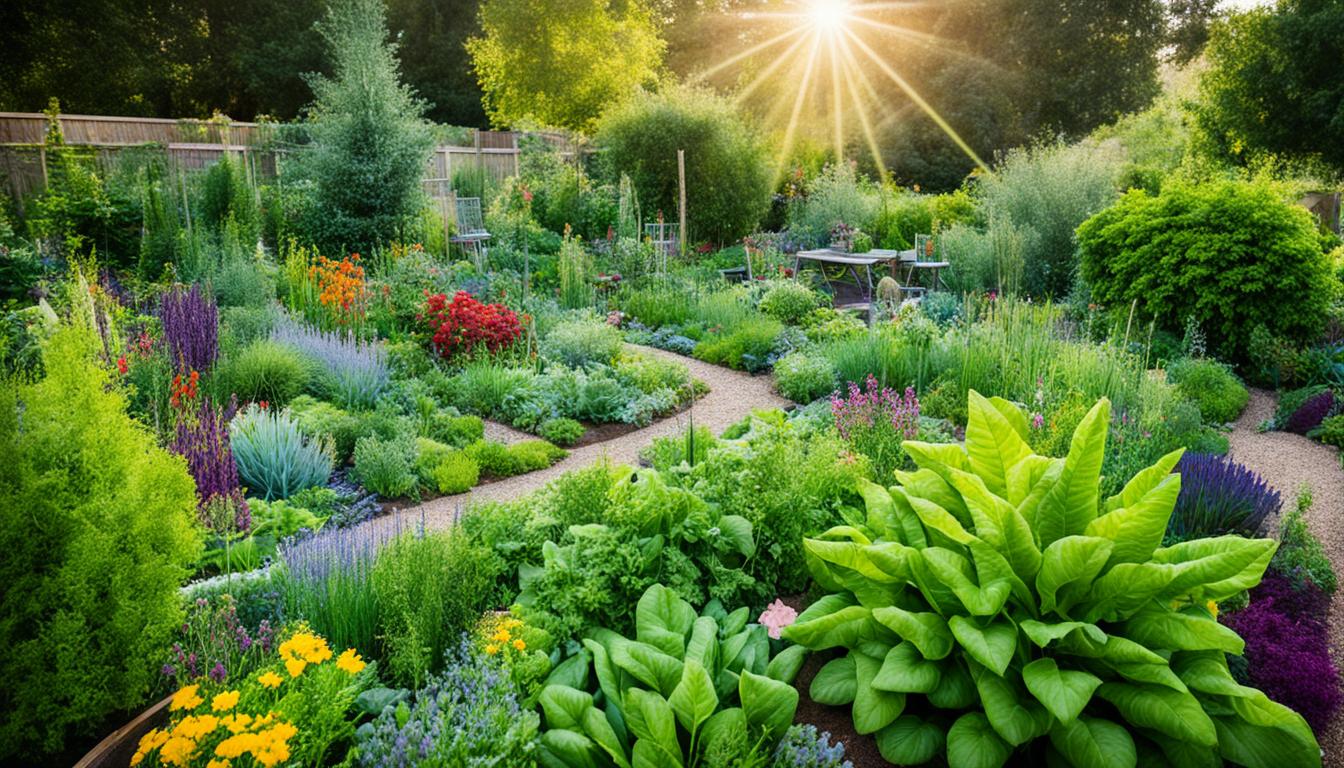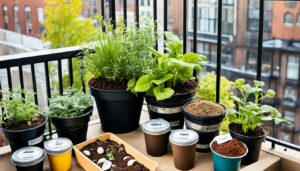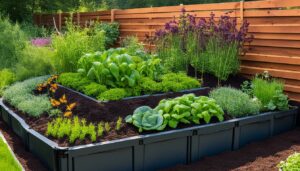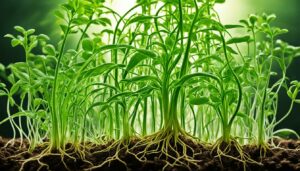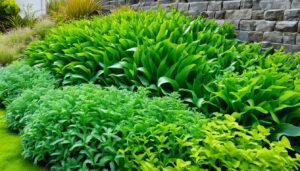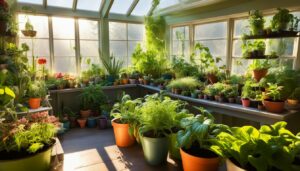“The garden suggests there might be a place where we can meet nature halfway.” These words by Michael Pollan encapsulate the essence of permaculture for the home gardener. It’s a gentle, yet powerful intersection of human ingenuity and nature’s wisdom—a practice where sustainable living blooms from each fertile corner of organic gardening. This ethos informs the pathway many are now pursuing in regenerative agriculture and eco-friendly gardening practices. The journey begins in the backyard: turning over a new leaf to cultivate both the land and our connection to it.
Permaculture home gardening is more than just planting—it’s about designing ecosystems. It’s an invitation to edible landscaping that lets us reap what we sow while enriching the Earth that cradles our roots. For those who kneel in the soil, hands deep in the earth, it’s an ongoing conversation with the complex web of life that sustains us. By following these principles, home gardeners nourish their environments, creating spaces that are not only abundant in yields but also in harmony with the natural world.
Key Takeaways
- Embrace permaculture to foster sustainable living and ecological balance.
- Implement organic gardening methods to cultivate food justice and soil health.
- Utilize edible landscaping as a medium for nurturing both land and community.
- Integrate regenerative agriculture principles for an eco-friendly gardening practice.
- Adopt closed-loop systems to produce in concert with nature’s patterns.
- Deepen your permaculture knowledge with resources such as Deep Green Permaculture and Permaculture News.
Understanding Permaculture and Its Relevance to Home Gardening
Embarking on a journey towards organic gardening and sustainable living leads many to the resilient practices of permaculture. This holistic approach is not simply a set of techniques but a philosophy that envelops ethical principles and design methodologies, fostering an intimate connection with our environment.
Origins of Permaculture Methodology
In the 1970s, visionaries Bill Mollison and David Holmgren planted the seeds for what we understand as permaculture today. Marrying permanence with agriculture, they devised a self-sustaining system that emulates the dynamic stability found in natural ecosystems. Their foundational work introduced a framework that revolutionizes the way we cultivate our gardens, aiming for abundant yields with minimal intervention.
Bioregionalism: Living in Harmony with Local Ecosystems
Permaculture is deeply intertwined with the concept of bioregionalism. This principle advocates for a deep understanding and respect for the local environment, celebrating and nurturing ecological diversity. Companion planting and homesteading techniques are applied with cognizance of local flora and fauna, optimizing resource conservation, and ensuring our gardening efforts contribute positively to the surrounding nature.
Eco-Friendly Gardening Practices: Aligning with Nature’s Patterns
Adhering to permaculture principles, gardeners are encouraged to observe and integrate natural patterns and cycles. This approach seeks to mitigate waste and tap into renewable resources, building systems that align with the rhythms of the earth. The practices fostered by permaculture are marked not just by efficiency but by a philosophy grounded in the ethics of care for the earth and its inhabitants.
| Permaculture Principle | Application in Home Gardening | Benefits for Sustainable Living |
|---|---|---|
| Observe and Interact | Designing gardens based on local weather patterns and land topography | Increases garden yield by working with, not against, natural conditions |
| Catch and Store Energy | Installing rain barrels for water collection and using solar-powered tools | Reduces reliance on non-renewable resources and decreases utility costs |
| Use and Value Renewable Resources | Using organic matter for mulch and compost instead of synthetic fertilizers | Creates a self-perpetuating cycle of nutrients, enriching soil without chemicals |
| Produce No Waste | Employing compost systems and regenerative practices | Transforms waste into valuable resources, closing the loop in garden ecosystems |
| Use Small and Slow Solutions | Starting with a small, manageable plot and expanding gradually | Encourages mindful growth and prevents overextension of resources |
Permaculture Home Gardener – Integrating Perennial Crops and Soil Health
Embracing permaculture principles for home gardens presents an innovative, sustainable path in harmonizing with Earth’s natural ecosystems. By focusing on soil health management and the cultivation of edible landscaping, we discover how permaculture not only benefits our plates but also nurtures the very ground we walk on. This section delves deeper into the permaculture practices that enrich soil vitality and enhance the ecosystem through perennial cropping.
Growing Your Soil: Beyond Traditional Tilling
Conventional gardening often relies on tilling, a practice that disrupts soil structure and microbiota. In contrast, permaculture approaches soil as a living entity, encouraging regenerative agriculture methods that promote its health. The incorporation of layers of cardboard, leaves, and grass clippings—a practice known as sheet mulching—creates fertile beds without the need for invasive tilling. These layers decompose gradually, enriching the soil with nutrients and creating an ideal environment for beneficial organisms.
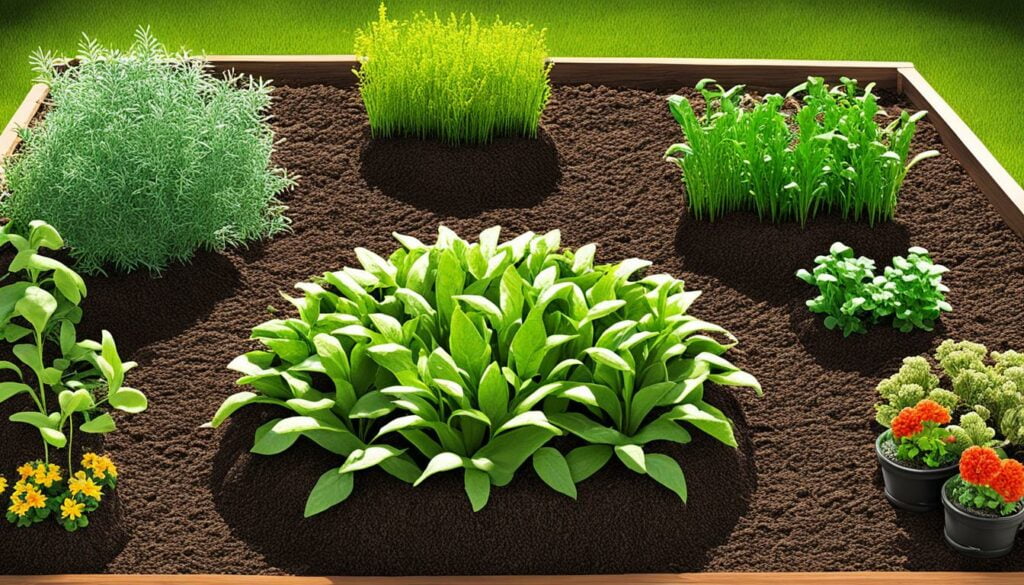
The Benefits of Perennial Plants for Long-Term Sustainability
Cultivating perennial plants is a cornerstone of edible landscaping and is favorably recognized for their low maintenance and resilience. Unlike annuals, perennials do not need to be replanted each year, saving labor and resources. Their deep root systems break up compacted soil, enhance its structure, and increase water retention. This natural cycle bolsters soil health management and contributes to a self-sustaining garden ecosystem.
Resource Conservation through Creative Garden Design
Innovative garden designs play a pivotal role in conserving resources and maximizing space efficiency. Employing methods such as polyculture planting and integrating various plant heights to create dynamic microclimates, positively impacts plant diversity and health. Such strategies, aligned with eco-friendly gardening practices, optimize the use of available resources by reducing water usage, minimizing waste, and promoting a self-replenishing landscape. The comparison table below illustrates how permaculture gardening approaches contribute to resource conservation.
| Permaculture Practice | Resource Conserved | Beneficial Impact |
|---|---|---|
| Sheet Mulching | Soil Fertility | Builds soil health without disrupting microbial life |
| Perennial Planting | Water and Nutrients | Deep roots systems improve water infiltration and nutrient cycling |
| Polyculture Gardens | Space and Biodiversity | Promotes diverse habitats and efficient space utilization |
By actively incorporating these permaculture practices, the home gardener takes a significant stride towards ecological stewardship. A garden designed with permaculture principles is not just a source of food, but a model of enduring sustainability, fostering a connection with the natural world through mindful and eco-friendly gardening practices.
Conclusion
In the journey toward sustainable living, permaculture presents itself not just as a set of practices, but as a guiding philosophy for the home gardener seeking harmony with the environment. It’s a path paved with the intent to nurture, protect, and revitalize our earth, drawing on regenerative agriculture and eco-friendly gardening practices that offer a blueprint for the future of food cultivation and land use. Permaculture transcends traditional agricultural techniques, promoting an ethical triad of Earth Care, People Care, and Fair Share, echoing the necessity for symbiotic relationships between humans and nature.
Gardeners who adopt this approach find themselves at the forefront of an agricultural transformation. By embracing edible landscaping and implementing companion planting, they enrich their gardens and, by extension, their diets with a diverse tapestry of fruits, vegetables, and herbs. The conscious focus on soil health management cultivates a legacy of fertile lands for future generations. Through resource conservation and thoughtful homesteading, permaculture advocates are sowing the seeds for an eco-conscious society grounded in the principles of conservation and resilience.
Ultimately, the permaculture home gardener is not just an individual cultivating their patch of green but is part of a larger, collective movement toward a more sustainable and just world. As each gardener intertwines their efforts with the cycles of the earth, they enact a quiet revolution, one that holds the potential to effect profound change in our global ecosystem. By fostering a deep connection between the land we till and the life we lead, permaculture becomes a testament to our ability to live thoughtfully and impactfully upon this planet.

